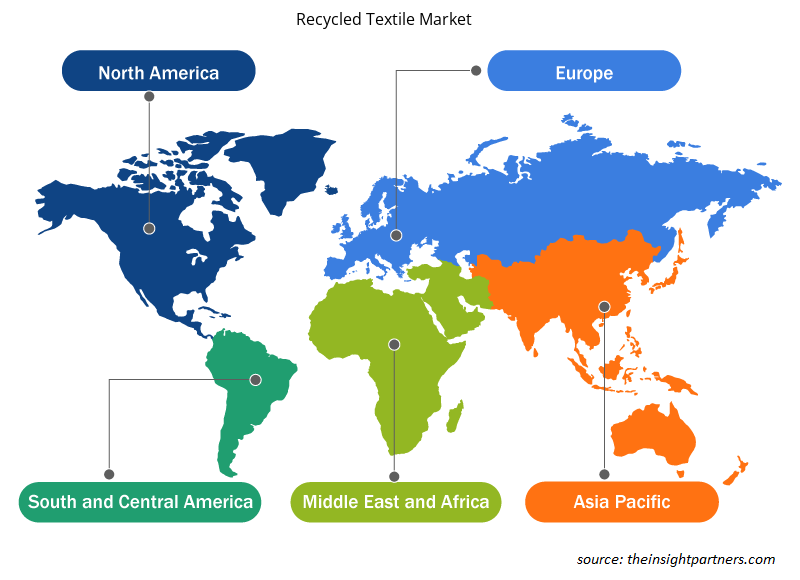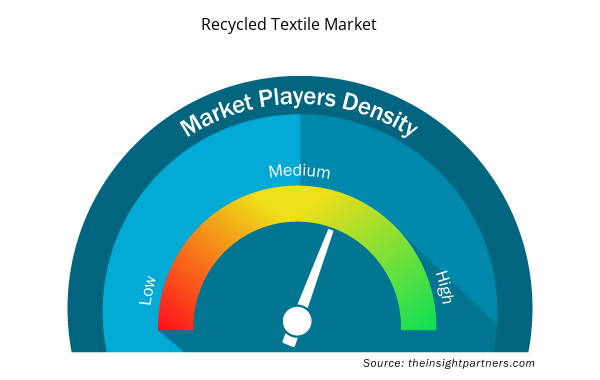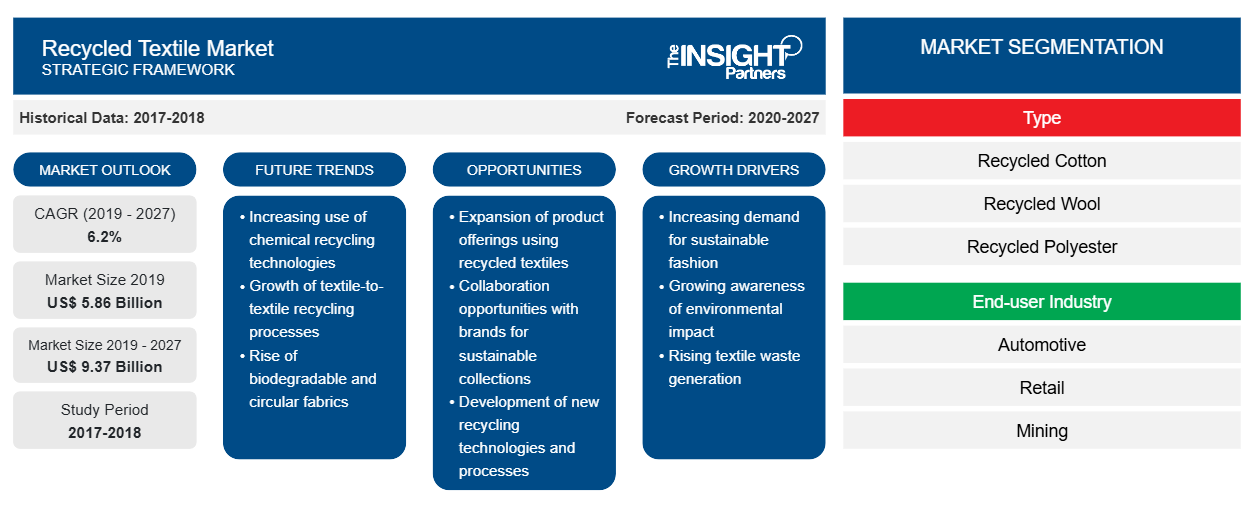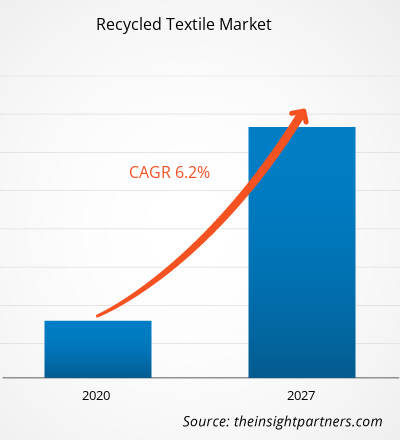재활용 섬유 시장 규모는 2019년에 58억 5,539만 달러였으며, 2027년까지 93억 6,504만 달러에 도달할 것으로 예상됩니다. 2020년에서 2027년까지 연평균 성장률 6.2%로 성장할 것으로 예상됩니다.
재활용 섬유는 재사용 또는 재료 회수를 위해 회수할 수 있는 오래된 옷이나 기타 미사용 섬유입니다. 최근 몇 년 동안 전 세계적으로 섬유 폐기물의 처분과 관련하여 환경에 부정적인 영향을 미칠 수 있는 우려가 커지고 있습니다. 재활용 섬유에 대한 수요는 의류, 직물, 자동차 및 기타를 포함한 여러 최종 사용 산업의 수요가 급증하면서 전 세계적으로 증가하고 있습니다. 제조업체는 사용된 섬유를 다양한 최종 사용 산업에서 사용할 수 있는 더 나은 제품으로 재활용하고 여러 기술을 채택했습니다. 자원 재활용은 주로 열, 기계 및 화학 기술의 도움으로 수행될 수 있습니다.
유럽은 이 지역의 정부 이니셔티브가 증가함에 따라 재활용 섬유에 대한 중요한 재활용 섬유 시장이 되었습니다 . 게다가 자동차 산업에서 재활용 섬유 제품에 대한 수요가 증가함에 따라 이 시장에서 활동하는 재활용 섬유 시장 참여자에게 수익성 있는 기회가 제공됩니다. 구매력 증가와 라이프스타일의 변화가 결합된 것은 유럽 지역의 섬유 시장 성장을 견인하는 주요 요인 중 하나입니다. 유럽에서는 소비자가 사용한 의류의 약 15%가 재활용되고, 사용 전 의류의 75% 이상이 제조업체에서 산업용으로 재활용됩니다. 유럽에서 재활용 섬유에 대한 수요는 지난 몇 년 동안 가장 빠른 속도로 증가하고 있습니다. 재활용 섬유 생산자는 독일, 영국 등의 국가에 초점을 맞추고 있으며, 이로 인해 유럽 지역에서 재활용 섬유에 대한 수요가 크게 증가했습니다. 순환 섬유 경제에 대한 소비자의 관심이 증가함에 따라 이 지역의 시장 성장이 더욱 촉진될 것으로 예상됩니다.
미국, 브라질, 인도, 러시아, 남아프리카, 멕시코, 스페인, 영국은 2020년 8월 현재 확진자와 사망자 수 측면에서 가장 큰 영향을 받은 국가에 속합니다. COVID-19는 봉쇄, 여행 금지, 사업 중단으로 인해 다양한 국가의 경제와 산업에 영향을 미쳤습니다. 글로벌 화학 및 소재 산업은 COVID-19 발병으로 인한 공급망 단절, 제조 중단과 같은 심각한 혼란을 겪고 있는 주요 산업 중 하나입니다. 예를 들어, 중국은 제조의 글로벌 허브이자 다양한 산업의 가장 큰 원자재 공급업체입니다. 중국과 아시아 태평양, 유럽과 같은 주요 지역의 다양한 공장과 공장의 봉쇄는 글로벌 공급망에 영향을 미치고 다양한 제품의 제조, 배송 일정 및 판매에 부정적인 영향을 미치고 있습니다. 이러한 모든 요인은 글로벌 재활용 섬유 시장에 큰 영향을 미쳤습니다.
귀하의 요구 사항에 맞게 이 보고서를 사용자 정의하세요
이 보고서의 일부 또는 국가 수준 분석, Excel 데이터 팩을 포함하여 모든 보고서에 대한 사용자 정의를 무료로 받을 수 있으며 신생 기업 및 대학을 위한 훌륭한 혜택과 할인 혜택을 이용할 수 있습니다.
- 이 보고서의 주요 시장 동향을 알아보세요.이 무료 샘플에는 시장 동향부터 추정 및 예측까지 다양한 데이터 분석이 포함됩니다.
시장 통찰력
섬유 폐기물 처리와 관련된 우려 증가
섬유 제조 메커니즘은 운영 전반에 걸쳐 대량의 섬유 폐기물을 생성하는 화학 집약적 공정 중 하나로 간주됩니다. 섬유 폐기물은 소비자 이전 섬유 폐기물과 소비자 이후 섬유의 두 그룹으로 구분할 수 있습니다. 섬유 폐기물의 양이 증가하면 환경에 부담이 되고 기존 매립지에서 효과적인 폐기 또는 소각 문제가 발생합니다. 추정에 따르면 모든 미사용 섬유 제품의 약 10~20%가 낭비되는 것으로 간주됩니다. 예를 들어, 미국 환경보호청(EPA)에 따르면 2015년에 총 1,575만 톤의 섬유가 도시 고형 폐기물로 생성되었으며 그 중 19%는 소각되었고 65%는 매립되었습니다. 또한 미국 환경보호청의 보고서에 따르면 섬유의 생산 및 폐기로 인해 온실 가스가 배출된다고 합니다. 또한 소각 과정에서 중금속, 다이옥신, 산성 가스 및 먼지 입자와 같은 유기 물질이 배출되며 이는 인간과 환경 모두에 해로운 것으로 간주됩니다. 또한, 잔류 재의 처리도 독성 물질이 고농도로 포함되어 있기 때문에 심각한 문제가 되었습니다. 따라서 환경 지속 가능성을 촉진할 수 있는 재사용 또는 재활용 방법을 통해 섬유 폐기물을 효과적으로 관리하는 것이 매우 중요합니다. 이러한 상황에서 섬유 폐기물의 재활용은 실행 가능한 대안으로 간주되며, 이는 천연 자원에 대한 부담을 줄이고 매립지 공간의 필요성을 최소화하며 에너지를 절약하는 데 도움이 됩니다. 게다가 섬유 폐기물의 효과적인 관리를 규제하는 엄격한 정부 법률은 폐기물과 관련된 임박한 문제를 처리하기 위한 지속 가능한 대안으로 섬유 재활용을 사용하도록 촉진하는 것을 목표로 합니다.
유형 통찰력
재활용 섬유 시장은 유형에 따라 재활용 면, 재활용 울, 재활용 폴리에스터, 재활용 나일론 등으로 세분화됩니다. 재활용 나일론 세그먼트는 2019-2027년 예측 기간 동안 가장 빠른 성장률을 기록할 것으로 예상됩니다. 재활용 나일론은 산업용 플라스틱, 폐기물 섬유, 직조 공장에서 나온 폐기물, 소비자 후 어망으로 만들어집니다. 이들은 처녀 나일론과 동일한 품질을 가진 새로운 나일론으로 재생됩니다. 나일론 백, 나일론 원단, 나일론 카펫도 재활용 나일론으로 전환되어 추가 사용이 가능합니다. 재활용 나일론의 상당 부분은 어망에서 나옵니다. 이는 바다 쓰레기를 돌리는 훌륭한 솔루션 역할을 합니다. 나일론 재활용은 나일론에 비해 비용이 많이 드는 공정이지만 많은 환경적 이점을 제공합니다. 나일론을 재활용하면 폐기물을 없애고 제조로 인한 온실 가스 배출량을 줄일 수 있습니다. 이는 원자재 공급원으로서 석유에 대한 의존도를 낮춥니다. 재활용 나일론을 사용하면 더 이상 사용되지 않는 나일론 제품에 대한 새로운 재활용 스트림을 촉진하는 데에도 도움이 됩니다. 대부분의 기계적으로 재활용된 재료는 고온에서 녹으며, 이는 오염 물질을 파괴하고 재료를 재사용 가능한 형태로 변형시킵니다. 나일론은 재활용하는 동안 저온에서 녹아 오염 물질을 남깁니다. 따라서 나일론은 재활용하기 전에 주의 깊게 세척해야 합니다.
최종 사용자 산업 통찰력
최종 사용자 산업을 기준으로 재활용 시장은 자동차, 소매, 광업 및 기타로 세분화됩니다. 자동차 부문은 2019-2027년 예측 기간 동안 가장 빠른 성장률을 기록할 것으로 예상됩니다. 자동차 산업에서 사용되는 재활용 섬유는 자동차 구성품 생산에 큰 기여를 합니다. 자동차 응용 분야에서 재활용 섬유를 사용하는 데는 바닥재, 실내 장식, 안전 벨트와 같은 눈에 보이는 구성품과 튜브 및 테이프, 타이어 코드, 에어백 구성품 및 섬유와 같은 시청자에게 보이지 않는 재활용 섬유가 포함됩니다. 재활용 섬유는 인장 강도, 마모, 공기 투과성, 압축 저항성, 탄성, 세척 용이성, 내염성 및 동적 기후 조건에 대한 저항성으로 인해 자동차 산업에서 사용됩니다. 재활용 면은 시트 충전재 또는 자동차 단열재에 사용됩니다.
Anandi Enterprises, Chindi, Khaloom Textile India Pvt. Ltd., Kishco Group 등은 글로벌 재활용 섬유 시장에서 활동하는 주요 기업입니다. 이러한 기업은 고객 기반을 확대하고 전 세계적으로 상당한 시장 점유율을 확보하기 위해 신제품 개발 및 합병 및 인수 전략을 실행하고 있으며, 이를 통해 기업은 전 세계적으로 브랜드 이름을 유지할 수 있습니다.
재활용 섬유 시장 지역 통찰력
Insight Partners의 분석가들은 예측 기간 동안 재활용 섬유 시장에 영향을 미치는 지역적 추세와 요인을 철저히 설명했습니다. 이 섹션에서는 북미, 유럽, 아시아 태평양, 중동 및 아프리카, 남미 및 중미의 재활용 섬유 시장 세그먼트와 지리에 대해서도 설명합니다.

- 재활용 섬유 시장에 대한 지역별 특정 데이터 얻기
재활용 섬유 시장 보고서 범위
| 보고서 속성 | 세부 |
|---|---|
| 2019년 시장 규모 | 58억 6천만 달러 |
| 2027년까지 시장 규모 | 93억 7천만 달러 |
| 글로벌 CAGR (2019-2027) | 6.2% |
| 역사적 데이터 | 2017-2018 |
| 예측 기간 | 2020-2027 |
| 다루는 세그먼트 | 유형별로
|
| 포함된 지역 및 국가 | 북아메리카
|
| 시장 선도 기업 및 주요 회사 프로필 |
|
시장 참여자 밀도: 비즈니스 역학에 미치는 영향 이해
재활용 섬유 시장 시장은 소비자 선호도의 변화, 기술 발전, 제품의 이점에 대한 인식 증가와 같은 요인으로 인해 최종 사용자 수요가 증가함에 따라 빠르게 성장하고 있습니다. 수요가 증가함에 따라 기업은 제품을 확장하고, 소비자의 요구를 충족하기 위해 혁신하고, 새로운 트렌드를 활용하여 시장 성장을 더욱 촉진하고 있습니다.
시장 참여자 밀도는 특정 시장이나 산업 내에서 운영되는 회사나 기업의 분포를 말합니다. 주어진 시장 공간에 얼마나 많은 경쟁자(시장 참여자)가 존재하는지 그 규모나 전체 시장 가치에 비해 나타냅니다.
재활용 섬유 시장에서 활동하는 주요 회사는 다음과 같습니다.
- 친디
- 칼룸 텍스타일 인디아 주식회사
- 키시코 그룹
- 우샤 얀스 리미티드
- 아난디 엔터프라이즈
면책 조항 : 위에 나열된 회사는 어떤 특별한 순서에 따라 순위가 매겨지지 않았습니다.

- 재활용 섬유 시장의 주요 참여자 개요를 알아보세요
스포트라이트 보고서
- 글로벌 재활용 섬유 시장의 진보적인 산업 동향은 기업이 효과적인 장기 전략을 개발하는 데 도움이 됩니다.
- 선진국과 개발도상국 시장에서 채택한 사업 성장 전략
- 2017년부터 2027년까지 글로벌 재활용 섬유 시장의 정량적 분석
- 다양한 산업에 걸친 글로벌 재활용 섬유 수요 추산
- 산업에서 운영되는 구매자와 공급자의 효율성을 보여주기 위한 PEST 분석으로 시장 성장을 예측합니다.
- 경쟁 시장 상황과 글로벌 재활용 섬유 수요를 이해하기 위한 최근 동향
- 글로벌 재활용 섬유 시장 성장을 촉진하고 제한하는 요인과 함께 시장 동향 및 전망
- 글로벌 재활용 섬유 시장 성장과 관련하여 상업적 관심을 뒷받침하는 전략을 이해하여 의사 결정 프로세스
- 다양한 시장 노드별 글로벌 재활용 섬유 시장 규모.
- 글로벌 재활용 섬유 시장의 자세한 개요 및 세분화와 업계 내 역학
- 유망한 성장 기회를 지닌 다양한 지역의 글로벌 재활용 섬유 시장 규모
유형별 글로벌 재활용 섬유 시장
- 재활용 코튼
- 재활용 양모
- 재활용 폴리에스터
- 재활용 나일론
- 기타
최종 사용자 산업별 글로벌 재활용 섬유 시장
- 자동차
- 소매
- 채광
- 기타
회사 프로필
- 아난디 엔터프라이즈
- 친디
- 칼룸 텍스타일 인디아 유한회사
- 키시코 그룹
- 우샤 얀스 리미티드
- 효성(주)
- 리 파이버 주식회사
- 마르텍스 파이버 서던 코퍼레이션
- 리뉴셀 AB
- 보어 그룹
- 역사적 분석(2년), 기준 연도, CAGR을 포함한 예측(7년)
- PEST 및 SWOT 분석
- 시장 규모 가치/양 - 글로벌, 지역, 국가
- 산업 및 경쟁 환경
- Excel 데이터 세트


- Aesthetic Medical Devices Market
- Fish Protein Hydrolysate Market
- Advanced Planning and Scheduling Software Market
- Non-Emergency Medical Transportation Market
- Artificial Turf Market
- Webbing Market
- Nitrogenous Fertilizer Market
- Intradermal Injection Market
- Terahertz Technology Market
- Molecular Diagnostics Market

Report Coverage
Revenue forecast, Company Analysis, Industry landscape, Growth factors, and Trends

Segment Covered
This text is related
to segments covered.

Regional Scope
North America, Europe, Asia Pacific, Middle East & Africa, South & Central America

Country Scope
This text is related
to country scope.
자주 묻는 질문
Rising concerns related to the disposal of textile waste across the globe which may negatively impact the environment. The textile manufacturing mechanism is considered to be one of the chemical-intensive processes which generate a high volume of textile waste throughout its operations. The textile waste may be segregated into two groups, pre-consumer textile waste and post-consumer textile. The rise in amount of textile waste creates a burden on environment and generates the problem of effective disposal or incineration on existing landfills. According to an estimate, approximately 10–20% of all unused textile products are considered to be wasted. For instance, according to US EPA, in 2015, a total of 15.75 million tons of textiles were generated as municipal solid waste, of which 19% were incinerated, while 65 percent, ended in landfills.
Based on end user industry, the global recycled textiles market is segmented into automotive, retail, mining and others. The worldwide production of apparel and textile fibers has increased, owing to the tremendous rise in the global population. This has resulted in the generation of a high amount of textile wastes. In order to ensure sustainability and reduce the environmental impact, the textile and retail sectors have resorted to the recycling of textiles, which is a method of reusing and reprocessing used clothing, fibrous material, and clothing scraps from the manufacturing processes. Unwearable textiles are treated as damaged textiles and are processed in the factories as rags. The rags are collected and sent to the flocking and wiping industries.
The recycled nylon emerged as the fastest growing segment in the global market. Recycled nylon is made from industrial plastics, waste fibers, discards from weaving mills, and post-consumer fishing nets. They are regenerated into new nylon, which has the same quality as that of virgin nylon. Nylon bags, nylon fabrics, and nylon carpets are also converted into recycled nylon for further use. A large proportion of the recycled nylon comes from the fishing nets. It acts as a great solution to divert ocean garbage.
On the basis of type, the recycled textiles market is categorized into recycled cotton, recycled wool, recycled polyester, recycled nylon and others. In 2019, the recycled polyester segment dominated the market by accounting for 33.0% of the total market share. Over the period of the time, it has been observed that the consumption of polyester has been increased, which has perpetually increased the amount of waste. This propels the need to recycle polyester which helps to save energy and promote environment sustainability. Further, the textile produced from recycled polyester has the potential of being recycled repeatedly without posing any effect on the quality of the material. Also, the use of recycled polyester eliminates the dependency on petroleum as a raw material for the manufacture of fabrics. The manufactures involved in the business of recycled textiles mainly use closed-loop processes to refine old polyester into raw materials used for the production of new garments and other items.
The major players operating in the global recycled textile market are companies such as Gebrueder Otto Gmbh and Co. kg, Leigh Fibers Inc., Martex Fiber Southern Corp, Re NewcellAB, and Khaloom Textiles India Pvt. Ltd.
During the forecast period, Asia Pacific is anticipated to account for the largest share in the global recycled textile market, followed by Europe. The largest market share of the Asia Pacific region is primarily attributable to the growth of recycled textile market in China and the country currently holds 28.0% market share in Asia Pacific region. Fashion is the second most polluting industry in operation internationally, and the increasing pollution concerns in China has also influenced the recycled textile industry in the country. Rapid urbanization coupled with shift in lifestyle and rise in disposable income amongst consumer have altogether driven the demand for textile, leading to rise in amount of textile waste in the region. Hence, recycling of textile waste has been adopted as a suitable alternative amongst developed and developing economies of the region to keep in line with objective of environment sustainability.
Trends and growth analysis reports related to Chemicals and Materials : READ MORE..
The List of Companies - Recycled Textile Market
- Chindi
- Khaloom Textile India Pvt. Ltd
- Kishco Group
- Usha Yarns Limited
- Anandi Enterprise
- Boer Group
- Hyosong Corporation
- Leigh Fibers Inc.
- Martex Fiber Southern Corporation
- Renewcell AB
The Insight Partners performs research in 4 major stages: Data Collection & Secondary Research, Primary Research, Data Analysis and Data Triangulation & Final Review.
- Data Collection and Secondary Research:
As a market research and consulting firm operating from a decade, we have published and advised several client across the globe. First step for any study will start with an assessment of currently available data and insights from existing reports. Further, historical and current market information is collected from Investor Presentations, Annual Reports, SEC Filings, etc., and other information related to company’s performance and market positioning are gathered from Paid Databases (Factiva, Hoovers, and Reuters) and various other publications available in public domain.
Several associations trade associates, technical forums, institutes, societies and organization are accessed to gain technical as well as market related insights through their publications such as research papers, blogs and press releases related to the studies are referred to get cues about the market. Further, white papers, journals, magazines, and other news articles published in last 3 years are scrutinized and analyzed to understand the current market trends.
- Primary Research:
The primarily interview analysis comprise of data obtained from industry participants interview and answers to survey questions gathered by in-house primary team.
For primary research, interviews are conducted with industry experts/CEOs/Marketing Managers/VPs/Subject Matter Experts from both demand and supply side to get a 360-degree view of the market. The primary team conducts several interviews based on the complexity of the markets to understand the various market trends and dynamics which makes research more credible and precise.
A typical research interview fulfils the following functions:
- Provides first-hand information on the market size, market trends, growth trends, competitive landscape, and outlook
- Validates and strengthens in-house secondary research findings
- Develops the analysis team’s expertise and market understanding
Primary research involves email interactions and telephone interviews for each market, category, segment, and sub-segment across geographies. The participants who typically take part in such a process include, but are not limited to:
- Industry participants: VPs, business development managers, market intelligence managers and national sales managers
- Outside experts: Valuation experts, research analysts and key opinion leaders specializing in the electronics and semiconductor industry.
Below is the breakup of our primary respondents by company, designation, and region:

Once we receive the confirmation from primary research sources or primary respondents, we finalize the base year market estimation and forecast the data as per the macroeconomic and microeconomic factors assessed during data collection.
- Data Analysis:
Once data is validated through both secondary as well as primary respondents, we finalize the market estimations by hypothesis formulation and factor analysis at regional and country level.
- Macro-Economic Factor Analysis:
We analyse macroeconomic indicators such the gross domestic product (GDP), increase in the demand for goods and services across industries, technological advancement, regional economic growth, governmental policies, the influence of COVID-19, PEST analysis, and other aspects. This analysis aids in setting benchmarks for various nations/regions and approximating market splits. Additionally, the general trend of the aforementioned components aid in determining the market's development possibilities.
- Country Level Data:
Various factors that are especially aligned to the country are taken into account to determine the market size for a certain area and country, including the presence of vendors, such as headquarters and offices, the country's GDP, demand patterns, and industry growth. To comprehend the market dynamics for the nation, a number of growth variables, inhibitors, application areas, and current market trends are researched. The aforementioned elements aid in determining the country's overall market's growth potential.
- Company Profile:
The “Table of Contents” is formulated by listing and analyzing more than 25 - 30 companies operating in the market ecosystem across geographies. However, we profile only 10 companies as a standard practice in our syndicate reports. These 10 companies comprise leading, emerging, and regional players. Nonetheless, our analysis is not restricted to the 10 listed companies, we also analyze other companies present in the market to develop a holistic view and understand the prevailing trends. The “Company Profiles” section in the report covers key facts, business description, products & services, financial information, SWOT analysis, and key developments. The financial information presented is extracted from the annual reports and official documents of the publicly listed companies. Upon collecting the information for the sections of respective companies, we verify them via various primary sources and then compile the data in respective company profiles. The company level information helps us in deriving the base number as well as in forecasting the market size.
- Developing Base Number:
Aggregation of sales statistics (2020-2022) and macro-economic factor, and other secondary and primary research insights are utilized to arrive at base number and related market shares for 2022. The data gaps are identified in this step and relevant market data is analyzed, collected from paid primary interviews or databases. On finalizing the base year market size, forecasts are developed on the basis of macro-economic, industry and market growth factors and company level analysis.
- Data Triangulation and Final Review:
The market findings and base year market size calculations are validated from supply as well as demand side. Demand side validations are based on macro-economic factor analysis and benchmarks for respective regions and countries. In case of supply side validations, revenues of major companies are estimated (in case not available) based on industry benchmark, approximate number of employees, product portfolio, and primary interviews revenues are gathered. Further revenue from target product/service segment is assessed to avoid overshooting of market statistics. In case of heavy deviations between supply and demand side values, all thes steps are repeated to achieve synchronization.
We follow an iterative model, wherein we share our research findings with Subject Matter Experts (SME’s) and Key Opinion Leaders (KOLs) until consensus view of the market is not formulated – this model negates any drastic deviation in the opinions of experts. Only validated and universally acceptable research findings are quoted in our reports.
We have important check points that we use to validate our research findings – which we call – data triangulation, where we validate the information, we generate from secondary sources with primary interviews and then we re-validate with our internal data bases and Subject matter experts. This comprehensive model enables us to deliver high quality, reliable data in shortest possible time.


 이 보고서에 대한 무료 샘플을 받으세요
이 보고서에 대한 무료 샘플을 받으세요